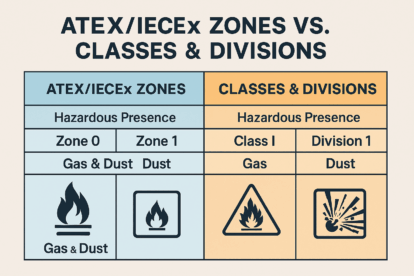Introduction
Across the GCC’s energy and industrial sectors, hazardous-area safety isn’t just a compliance requirement—it directly impacts plant reliability, worker safety, and operational uptime. Whether on an offshore platform, a refinery, a water treatment plant, or a chemical facility, choosing the correct explosion-proof lighting and instrumentation is critical.
At Daly Middle East, our team regularly supports engineers, consultants, and procurement teams who are navigating different global certification systems. The most common challenge we see is the confusion between the ATEX/IECEx Zone system (used internationally) and the Class/Division system (used predominantly in North America).
This case study explains how Daly Middle East helped a client select the right product despite conflicting certification terminology—ensuring full compliance and a safe installation.
Understanding the Two Systems at a Glance
1. ATEX / IECEx Zones (Europe, Middle East, Asia, Africa)
These standards classify hazardous areas based on the frequency and duration of the presence of explosive gas or dust:
- Zone 0 / 20: Hazard present continuously or for long periods
- Zone 1 / 21: Hazard likely during normal operations
- Zone 2 / 22: Hazard unlikely or occurs only for short duration
The Zone system provides a granular, time-based approach that helps engineers determine the right category of protection.
2. Classes & Divisions (North America)
This system categorizes hazardous areas by type of hazard and likelihood of occurrence:
Classes
- Class I – Gases and vapors
- Class II – Dust
- Class III – Fibres and flyings
Divisions
- Division 1 – Hazard likely during normal operations
- Division 2 – Hazard unlikely or abnormal
It is straightforward but more binary, compared to the detailed ATEX/IECEx zoning approach.
Why This Matters in the GCC
Within the UAE, Saudi Arabia, Oman, Qatar, and Kuwait, ATEX/IECEx is the most widely accepted framework for explosion-proof equipment. However, many suppliers based in the US—and several EPC contractors—still propose equipment certified only with Class/Division markings.
This mismatch often leads to confusion in tenders, incorrect product selection, or delays in approvals.
And that’s exactly what happened in this case.
Case Example: Correcting Incorrect Certification for a Petrochemical Facility
Client Overview (Anonymous)
A petrochemical facility in the GCC approached Daly Middle East for explosion-proof lighting for a Zone 1 classified process area, along with gas leak detection and signalling devices.
The Challenge
The client initially received a quotation from an external vendor for products rated Class I, Division 2. However, as per their site classification document, the installation location required Zone 1 protection.
Although both certifications deal with hazardous environments, they are not equivalent:
- Zone 1 ≠ Class I, Division 2
- Zone 1 typically aligns with Class I, Division 1 (higher safety requirement)
If installed incorrectly:
❌ The equipment could fail under explosive atmospheres
❌ Approvals from safety auditors would be rejected
❌ Plant operation risks and insurance liabilities would increase
How Daly Middle East Resolved It
- Detailed Area Classification Review
Our team studied the client’s documentation, focusing on:- Hazard type (gas)
- Frequency of exposure
- Adjacent zones
- Equipment operating temperature
- Certification Cross-Mapping
We explained to the client:- Why Class I Division 2 could not replace Zone 1
- How ATEX/IECEx EPL (Gb, Gc) maps to the required safety level
- What markings to look for on compliant luminaires/instruments
- Providing Compliant Equipment
Daly Middle East proposed:- Zone 1 certified explosion-proof lighting
- ATEX/IECEx approved signalling devices
- Gas detection equipment suitable for continuous exposure conditions
- Testing and Verification
All equipment was checked at Daly Middle East’s Dubai Investment Park (DIP) facility:- Functionality testing
- Temperature verification
- Certification tag verification
- Visual inspection before dispatch
- Client Result
- Fully compliant Zone 1 installation
- No shutdown delays
- Audit approval achieved
- Standardised specification to avoid future mis-interpretation
Comparison Summary (Simplified)
| ATEX / IECEx Zones | Classes & Divisions |
|---|---|
| Used in Europe, GCC, Middle East | Used in USA/Canada |
| Time-based hazardous presence | Likelihood-based presence |
| Zone 0/1/2 for gas | Class I Div 1/2 for gas |
| More globally recognised | Regionally focused |
| Common for oil & gas in GCC | Less used in GCC projects |
Key Takeaways for GCC Projects
✔ Always confirm your project’s certification standard
Even if equipment looks similar, the markings can define what is legally acceptable.
✔ Don’t assume equivalence
Zone 1 is not automatically interchangeable with Class I, Division 2.
✔ Partner with suppliers who understand both systems
Daly Middle East’s team regularly handles:
- Explosion-proof lighting
- Gas detection
- Instrumentation
- Signalling devices
- Confined space safety equipment
- Water & wastewater monitoring solutions
✔ Pre-delivery testing matters
With a dedicated service area at DIP, we verify every item before dispatch.
Conclusion
Having the correct certification is not only a compliance requirement—it ensures safety, reliability, and long-term operational efficiency. For companies operating in the GCC, understanding the differences between ATEX/IECEx Zones and the Class/Division system helps avoid costly mistakes.
As part of the recommendation, Daly Middle East included Red Sky Lighting’s ATEX/IECEx certified models, which are widely used across GCC industrial sites. Their reliability in Zone 1 and Zone 2 environments made them suitable for the revised specification.
📩 For consultation or product support, contact our technical team at Daly Middle East.
